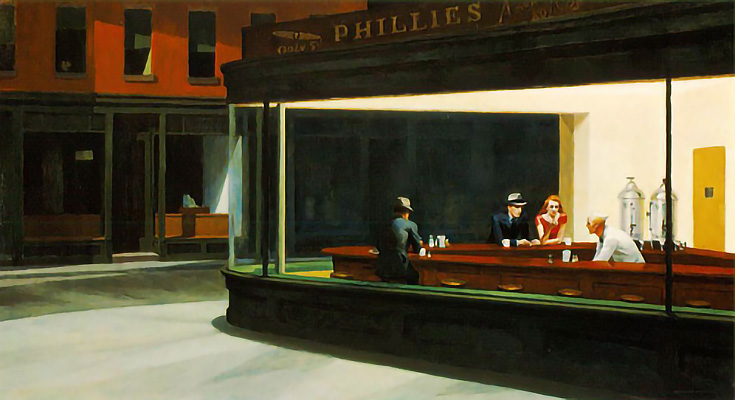Born in 1882 in New York, Edward Hopper is now recognized as one of the most influential American realist painters of the 20th century. Nighthawks, above, is undoubtedly his best-known work, and like many of his paintings has been referenced numerous times in American pop-culture.
Early on in life, however, Hopper was not so celebrated—he first made his living as a commercial artist and illustrator, and it wasn’t until the late 1920’s (well into his forties) that he could support himself full-time as a painter.
This next painting, Chop Suey, shows a slice of 20th century Americana that so many people love—but Hopper was different from the typical “Americana” artist.
Hopper’s paintings aren’t about a certain ideal, or to glorify a “simple” American way of life—not at all. Instead, he focused on scenes and places where things occurred: where people lived, or had lived. . . where they walked, or had walked.
And in many of Hopper’s paintings there’s a sense of displacement, too, as though we (the viewers) are seeing everything from behind a one-way mirror—stuck observing life, while never truly partaking of it.
Others, like Sun in an Empty Room, are especially powerful for different reasons.
An open window fills this room with glorious light. . . but it only serves to illuminate the perfect stillness and hollow out each empty corner with shadows.
Who among us hasn’t felt the loneliness of an empty room? Either moving in to a new home, or moving out of one where so many memories have been made? It’s a feeling that Hopper captures perfectly with just a bit of light and some simple architecture.
Of course, Hopper’s architecture is always stunning, simple or not. Early Sunday Morning shows an entire city block, window after window, doorway after door.
Bold colors, long shadows—for me, it’s these timeless, natural scenes that set Edward Hopper apart from other 20th century American artists.
This post may contain affiliate links.




